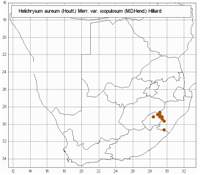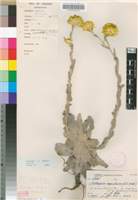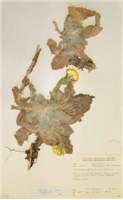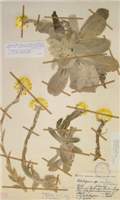Origin of name:
aureus / -a/ -um = golden
Diagnostic characters:
Basal leaf rosette
Plant woolly
Large solitary heads
Bright yellow bracts
Description:
Perennial herb, very variable in stature, in leaf-size and indumentum, and in head size, stock becoming very stout and woody, crown up to c. 25 mm diam. producing one or several leaf rosettes, flowering stems c. 50�300 mm high, simple or subsimple, loosely white-woolly or cottony. Radical leaves c. 30�80 (�110) x 20�30 (�40) mm, thickly greyish-white woolly, or wool sometimes sparse, narrowly or broadly elliptic-spathulate, apex obtuse to subacute, base broad, clasping; cauline up to 40 (�70) x 10 (�20) mm, loosely woolly at first, wool eventually confined to margins and main veins, oblong, oblong-lanceolate to lanceolate upwards, correspondingly obtuse, acute to acuminate, apiculate, base more or less cordate-clasping, very shortly decurrent in the larger leaves. Heads heterogamous, depressed-globose, (15�) 20 mm long, (30�) 35�45 mm across the radiating bracts, usually solitary, occasionally 2�3 subcorymbosely arranged on long leafy peduncles. Involucral bracts in c. 7�9 series, graded, imbricate, much exceeding flowers, radiating, glossy, yellow, outer usually overlaid buff or pale, brown. Receptacle scarcely honeycombed. Flowers 516�1253, 36�199 female, 360�1054 homogamous, yellow. Achenes 0,75�1 mm long, barrel-shaped, glabrous. Pappus bristles many, equaling corolla, tips barbellate, bases with patent cilia not or scarcely cohering.
Flowering mainly between July and December, with one record in April.
Distribution:
Grows mainly on rock faces, often in inaccessible places, sometimes on the boulders fallen from cliffs or occasionally on the steep rubble and grass slopes below cliffs, when it may then have less woolly leaves than cliff-face plants. Recorded only from the KwaZulu-Natal Drakensberg between Muller's Pass west of Newcastle and the Giant's Castle area, Estcourt district, between 1 645 and 2 750 m above sea level.
Grassland Biome.
Notes:
Six varieties are recognized:
la Involucral bracts yellow, outer sometimes pale brown or buff:
2a Heads mostly 15�20 mm long measured from base of outer involucral bracts to tips of longest inner ones, c. 35�45 mm across the fully radiating involucral bracts; if only 30 mm across, then on cliffs in the Drakensberg:
3a Flowering stems loosely woolly or cobwebby mostly throughout; flowering mainly between August and December:
4a Plants growing in grassland or scrub:
5a Cauline leaves only very lightly woolly, or wool confined to margins and midline
(a) var. aureum
5b Cauline leaves thickly and persistently silver-grey woolly
(f) var. argenteum
4b Plants growing on cliff faces or on rocky terrain immediately below cliffs in the Drakensberg
(b) var. scopulosum
3b Flowering stems woolly or cobwebby only in the uppermost part, flowering mainly between January and April
(c) var. serotinum
2b Heads mostly 8�15 mm long, up to 32 mm across the radiating bracts, growing in grassland
(d) var. monocephalum
1b Involucral bracts snow-white
(e) var. candidum
Taxonomy:
Literature:
Helichrysum aureum (Houtt.) Merrill var. scopulosum (M.D. Henderson) Hilliard in Notes R. bot. Gdn Edinb. 34: 80 (1975), Compositae in Natal 252 (1977).
Type:
KwaZulu-Natal, Bergville distr., Cathedral Peak Forest Research Station, 7 400 ft, Killick 1554 (PRE, holo.; K, iso.).
Synonym(s):
H. scopulosum M.D. Henderson in Bothalia 6: 423 (1954).
Vouchers:
Esterhuysen 15552 (BOL; PRE); Wright 293 (E; K; NU; S).



